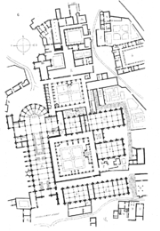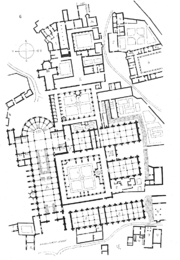
Clairvaux Abbey
Encyclopedia

Monastery
Monastery denotes the building, or complex of buildings, that houses a room reserved for prayer as well as the domestic quarters and workplace of monastics, whether monks or nuns, and whether living in community or alone .Monasteries may vary greatly in size – a small dwelling accommodating only...
in Ville-sous-la-Ferté
Ville-sous-la-Ferté
Ville-sous-la-Ferté is a commune in the Aube department in the Champagne-Ardenne region in north-central France.The best-known landmark of Ville-sous-la-Ferté is the nearby ruin of Clairvaux Abbey, now the site of Clairvaux Prison.-External links:*...
, 15 km from Bar-sur-Aube
Bar-sur-Aube
Bar-sur-Aube is a commune of France in the Aube department, of which it is a sub-prefecture.-Population:The inhabitants of the commune are called Baralbains.-Culture:*Market every Saturday morning in the halls...
, in the Aube
Aube
Aube is a department in the northeastern part of France named after the Aube River. In 1995, its population was 293,100 inhabitants.- History :Aube is one of the original 83 departments created during the French Revolution on 4 March 1790...
département in northeastern France
France
The French Republic , The French Republic , The French Republic , (commonly known as France , is a unitary semi-presidential republic in Western Europe with several overseas territories and islands located on other continents and in the Indian, Pacific, and Atlantic oceans. Metropolitan France...
. The original building, founded in 1115 by St. Bernard
Bernard of Clairvaux
Bernard of Clairvaux, O.Cist was a French abbot and the primary builder of the reforming Cistercian order.After the death of his mother, Bernard sought admission into the Cistercian order. Three years later, he was sent to found a new abbey at an isolated clearing in a glen known as the Val...
, is now in ruins; a high-security prison
Prison
A prison is a place in which people are physically confined and, usually, deprived of a range of personal freedoms. Imprisonment or incarceration is a legal penalty that may be imposed by the state for the commission of a crime...
, the Clairvaux Prison
Clairvaux Prison
Clairvaux Prison is a high-security prison in France, on the site of the former Clairvaux Abbey.-1971 revolt:In this prison in 1971, convicts Claude Buffet and Roger Bontems took Nicole Comte, a nurse, and Guy Girardot, a prison guard, hostage, and Buffet subsequently murdered them. Buffet and...
, now occupies the grounds. Clairvaux Abbey was a good example of the general layout of a Cistercian monastery
Monastery
Monastery denotes the building, or complex of buildings, that houses a room reserved for prayer as well as the domestic quarters and workplace of monastics, whether monks or nuns, and whether living in community or alone .Monasteries may vary greatly in size – a small dwelling accommodating only...
. The Abbey has been listed since 1926 as a Historical monument by the French Ministry of Culture.
Description
Cistercian monasteriesMonastery
Monastery denotes the building, or complex of buildings, that houses a room reserved for prayer as well as the domestic quarters and workplace of monastics, whether monks or nuns, and whether living in community or alone .Monasteries may vary greatly in size – a small dwelling accommodating only...
were all arranged according to a set plan unless the circumstances of the locality forbade it. A strong wall, furnished at intervals with watchtowers and other defenses, surrounded the abbey precincts. Beyond the wall, a moat, artificially diverted from tributaries which flow through the precincts, completely or partially encircled the wall. This water furnished the monastery with an abundant supply of water for irrigation
Irrigation
Irrigation may be defined as the science of artificial application of water to the land or soil. It is used to assist in the growing of agricultural crops, maintenance of landscapes, and revegetation of disturbed soils in dry areas and during periods of inadequate rainfall...
, sanitation and for the use of the offices and workshops.
An additional wall, running from north to south, bisected the monastery into an "inner" and "outer" ward. The inner ward housed the monastic buildings while the agricultural and other menial endeavors were carried out in the outer ward.
The precincts were entered by a gateway, at the extreme western extremity, giving admission to the lower ward. Here the barns, granaries, stables, shambles, workshops and workmens lodgings were located without any regard to symmetry, convenience being the only consideration. A single gatehouse afforded communication through the wall separating the outer from the inner ward. On passing through the gateway, the outer court of the inner ward was entered, with the western facade of the monastic church in front. Immediately on the right of entrance was the abbot's residence, in close proximity to the guest-house. On the other side of the court were the stables, for the accommodation of the horses of the guests and their attendants. The church occupied a central position. To the south was the great cloister
Cloister
A cloister is a rectangular open space surrounded by covered walks or open galleries, with open arcades on the inner side, running along the walls of buildings and forming a quadrangle or garth...
, surrounded by the chief monastic buildings. Further to the east, the smaller cloister contained the infirmary, novices' lodgings and quarters for the aged monks. Beyond the smaller cloister and separated from the monastic buildings by a wall, lay the vegetable gardens and orchards. Large fish ponds were also located in the area east of the monastic buildings. They were an important part of monastic life and much care was given to their construction and maintenance by the monks. The fish ponds often remain as one of the few visible traces of these vast monasteries.
The church consists of a vast nave of eleven bays, entered by a narthex
Narthex
The narthex of a church is the entrance or lobby area, located at the end of the nave, at the far end from the church's main altar. Traditionally the narthex was a part of the church building, but was not considered part of the church proper...
, with a transept and short apsidal choir. To the east of each limb of the transept are two square chapels, divided according to Cistercian rule by solid walls. Nine radiating chapels, similarly divided, surround the apse. The stalls of the monks, forming the ritual choir, occupy the four eastern bays of the nave. There was a second range of stalls in the extreme western bays of the nave for the lay brother
Lay brother
In the most common usage, lay brothers are those members of Catholic religious orders, particularly of monastic orders, occupied primarily with manual labour and with the secular affairs of a monastery or friary, in contrast to the choir monks of the same monastery who are devoted mainly to the...
s. The cloister was located to the south of the church so that its inhabitants could benefit from ample sunshine.
The chapter house
Chapter house
A chapter house or chapterhouse is a building or room attached to a cathedral or collegiate church in which meetings are held. They can also be found in medieval monasteries....
opened out of the east walk of the cloister in parallel with the south transept.

